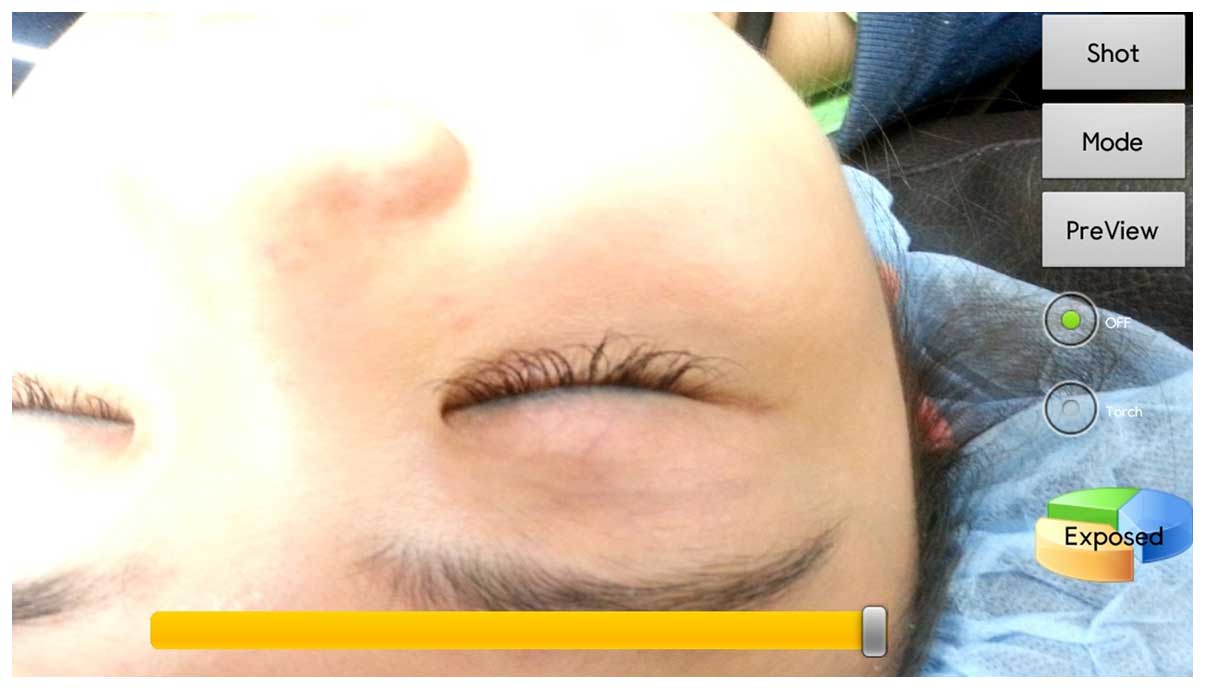
Assessment of pupillary light reflex using a smartphone application
- Authors:
- Young Duck Shin
- Jin Ho Bae
- Eun Jung Kwon
- Hyeon Tae Kim
- Tae‑Soo Lee
- Young Jin Choi
-
View Affiliations
Affiliations: Department of Anesthesiology and Pain Medicine, College of Medicine, Chungbuk National University, Cheongju, Chungcheongbuk-do 361‑763, Republic of Korea, Department of Biomedical Engineering, College of Medicine, Chungbuk National University, Cheongju, Chungcheongbuk-do 361‑763, Republic of Korea, Department of Surgery, College of Medicine, Chungbuk National University, Cheongju, Chungcheongbuk-do 361‑763, Republic of Korea
- Published online on: May 23, 2016 https://doi.org/10.3892/etm.2016.3379
-
Pages:
720-724
-
Copyright: © Shin
et al. This
is an open access article distributed under the
terms of Creative
Commons Attribution License.
Metrics:
Total
Views: 0 (Spandidos Publications: | PMC Statistics:
)
Metrics:
Total PDF Downloads: 0 (Spandidos Publications: | PMC Statistics:
)
This article is mentioned in:
Abstract
In unconscious patients, pupillary light reflex is an indicator of brain damage. In the current study, a smartphone application was developed for the purpose of measuring pupillary light reflex with an aim to determine the agreement between pupillary light reflex measurements using a smartphone application (APP) and a penlight (PEN). The APP acquires five sequential photographs using the camera flash in order to stimulate the pupil. The initial image is captured prior to the flash, and the subsequent image is obtained while the flash is on. The remaining three images are captured whilst the flash is off. Pupillary right reflex was assessed in 30 healthy subjects using a PEN. After 10 min, the examiners inspected the images of light reflex acquired from the same subjects using the APP, and completed the corresponding questionnaire containing details of pupil size and degree of response. Agreement between the two assessment methods was determined by calculating bias, limits of agreement, and the intraclass correlation (ICC) coefficient. A statistically significant difference was not observed between the two methods regarding pupil size and degree of response. Bias was 0.1 mm and limits of agreement were ±1.5 mm, as compared with PEN. ICC was 0.93 (95% confidence interval, 0.89‑0.96). Therefore, it may be concluded that the results of pupillary light reflex assessed by PEN and APP display no significant difference. Furthermore, the APP provides advantages such as portability, objectivity and the possibility of being used as objective medical evidence.
View References
|
1
|
Santhanam R, Pillai SV, Kolluri SV and Rao
UM: Intensive care management of head injury patients without
routine intracranial pressure monitoring. Neurol India. 55:349–354.
2007. View Article : Google Scholar : PubMed/NCBI
|
|
2
|
Meyer S, Gibb T and Jurkovich GJ:
Evaluation and significance of the pupillary light reflex in trauma
patients. Ann Emerg Med. 22:1052–1057. 1993. View Article : Google Scholar : PubMed/NCBI
|
|
3
|
Matouskova O, Slanar O, Chytil L and
Perilk F: Pupillometry in healthy volunteers as a biomarker of
tramadol efficacy. J Clin Pharm Ther. 36:513–517. 2011. View Article : Google Scholar : PubMed/NCBI
|
|
4
|
Jonathan CH: Disorders of the eye In:
Harrison's Principles of Internal Medicine. Longo DL, Fauci AS,
Kasper DL, Hauser SL, Jameson JL and Loscalzo J: I:(18th).
McGraw-Hill. New York: 224–225. 2012.
|
|
5
|
Zvornicanin E, Zvornicanin J and
Hadziefendic B: The use of smart phones in opthalmology. Acta
Inform Med. 22:206–209. 2014. View Article : Google Scholar : PubMed/NCBI
|
|
6
|
Jonathan CH: Disturbances in vision and
ocular movements. Harrison's Principles of Internal Medicine. Longo
DL, Fauci AS, Kasper DL, Hauser SL, Jameson JL and Loscalzo J:
I:(13th). McGraw-Hill. (New York). 1011994.
|
|
7
|
Léon L, Crippa SV, Borruat FX and Kawasaki
A: Differential effect of long versus short wavelenghth light
exposure on pupillary re-dilation in patients with outer retinal
disease. Clin Experiment Ophthalmol. 40:e16–e24. 2012. View Article : Google Scholar : PubMed/NCBI
|
|
8
|
Ellis CJ: The pupillary light reflex in
normal subjects. Br J Ophthalmol. 65:754–759. 1981. View Article : Google Scholar : PubMed/NCBI
|
|
9
|
Bergamin O and Kardon RH: Latency of the
pupil light reflex. Sample rate, stimulus intensity and variation
in normal subjects. Invest Ophthalmol Vis Sci. 44:1546–1554. 2003.
View Article : Google Scholar : PubMed/NCBI
|
|
10
|
Whiting RE, Yao G, Narfström K, Pearce JW,
Coates JR, Dodam JR, Castaner LJ and Katz ML: Quantitative
assessment of the canine pupillary light reflex. Invest Ophthalmol
Vis Sci. 54:5432–5440. 2013. View Article : Google Scholar : PubMed/NCBI
|














